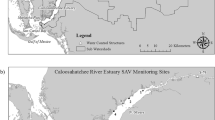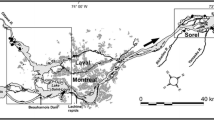Abstract
Patches of submerged vegetation can be important sites of primary production and habitat for organisms in many aquatic ecosystems. In the tidal freshwater Hudson River they make up about 6% of the river bottom area. Direct sampling of water masses passing through patches of vegetation and week-long continuous monitoring of water characteristics were used to determine plant effects on dissolved oxygen and suspended sediments. Vegetated areas could have dissolved oxygen concentrations substantially higher than in the main channel and suspended sediments and turbidity were frequently higher in vegetated areas. Patches of Vallisneria americana had variable capacity to maintain super-saturated oxygen concentrations; patch size accounted for some of the variability whereas larger-scale differences in main-channel influent water also contributed. Differences in turbidity among sites were harder to account for; width of plant beds and abundance of neighboring vegetated areas contributed weakly to predictions of local turbidity. Functional heterogeneity within ecosystems is common and attempts to explain variability may require understanding different controlling factors for different functions and appreciating that factors operate at multiple scales.






Similar content being viewed by others
References
Barko JW, James WF. 1998. Effects of submerged macrophytes on nutrient dynamics, sedimentation, and resuspension. In: Jeppesen E, Søndergaard M, Søndergaard M, Christoffersen K (eds). The structuring role of submerged macrophytes in lakes. New York: Springer-Verlag. pp 197–214
Caraco NF, Cole JJ, Findlay SEG, Fischer DT, Lampman GG, Pace ML, Strayer DL. 2000. Dissolved oxygen declines in the Hudson River associated with the invasion of the Zebra Mussel (Dreissena polymorpha). Environ Sci Technol 34:1204–10
Caraco NF, Cole JJ. 2002. Contrasting impacts of a native and alien macrophyte on dissolved oxygen in a large river. Ecol Appl 12(5):1496–509
Carpenter SR, Lodge DM. 1986. Effects of submersed macrophytes on ecosystem processes. Aquat Bot 26:341–70
Carter V, Barko JW, Godshalk GL, Rybicki NB. 1988. Effects of submersed macrophytes on water-quality in the tidal Potomac River, Maryland. J Freshw Ecol 4(4):493–501
Carter V, Rybicki NB, Hammerschlag R. 1991. Effects of submersed macrophytes on dissolved oxygen, pH, and temperature under different conditions of wind, tide, and bed structure. J Freshw Ecol 6(2):121–33
Cole JJ, Caraco NF. 2001. Carbon in catchments: connecting terrestrial carbon losses with aquatic metabolism. Mar Fresh Res 52:101–10
Cole JJ, Caraco NF, Peierls B. 1992. Phytoplankton primary production in the tidal freshwater Hudson River, New York (USA). Verhandlungen der Internationalen Vereinigun fur Theoretische und Angewandte Limonologie 24:1715–19
Findlay S, Pace M, Fischer D. 1996. Spatial and temporal variability in the lower food web of the tidal freshwater Hudson River. Estuaries 19:866–73
Findlay S, Sinsabaugh RL, Fischer DT, Franchini P. 1998. Sources of dissolved organic carbon supporting planktonic bacterial production in the tidal freshwater Hudson River. Ecosystems 1:227–39
Fonseca MS, Fisher JS, Zieman JC, Thayer GW. 1982. Influence of the seagrass, Zostera marina L., on current flow. Estuar Coast Shelf Sci 15:351–64
Fonseca MS, Whitfield PE, Kelly NM, Bell SS. 2002. Modelling seagrass landscape pattern and associated ecological attributes. Ecol Appli 12:212–37
Harley MT, Findlay S. 1994. Photosynthesis-irradiance relationships for three species of submersed macrophytes in the tidal freshwater Hudson River. Estuaries 17:200–05
Harlin MM, Thorne-Miller B. 1982. Seagrass-sediment dynamics of a flood-tidal delta in Rhode Island (U.S.A.). Aquat Bot 14:127–38
Howarth RW, Schneider R, Swaney D. 1996. Metabolism and organic carbon fluxes in the tidal freshwater Hudson River. Estuaries 19:848–65
Kemp MW, Boynton WR, Twilley RR. 1984. Influences of submersed vascular plants on ecological processes in upper Chesapeake Bay. In: Kennedy V (eds). The estuary as a filter. Orlando: Academic. pp 367–94
Kenworthy WJ, Zieman JC, Thayer GW. 1982. Evidence for the influence of seagrass on the benthic nitrogen cycle in a coastal plain estuary near Beaufort, North Carolina (U.S.A.). Oecologia 54:152–8
Koch EW. 1999. Sediment resuspension in a shallow Thalassia testudinum (banks ex Konig) bed. Aquat Bot 65:269–80
Lampman GG, Caraco NF, Cole JJ. 1999. Spatial and temporal patterns of nutrient concentration and export in the tidal Hudson River. Estuaries 22(2A):285–96
Losee RF, Wetzel RG. 1988. Water movement within submersed littoral vegetation. Verhandlungen Internationale Vereinigung für Theoretische und Angewandte Limnologie 23:62–6
McClain ME, Boyer EW, Dent CL, Gergel SE, Grimm NB, Groffman PM, Hart SC, Harvey JW, Johnston CA, Mayorga E, McDowell WH, Pinay G. 2003. Biogeochemical hot spots and hot moments at the interface of terrestrial and aquatic ecosystems. Ecosystems 6:301–12
Nieder WC, Barnaba EM, Findlay S, Hoskins S, Holochuk N, Blair EA. 2004. Distribution and abundance of submerged aquatic vegetation in the Hudson River Estuary. J Coast Res Sp.Iss 45:150–161
Posey MH, Wigand C, Stevenson JC. 1993. Effects of an introduced aquatic plant, Hydrilla verticillata, on benthic communities in the upper Chesapeake Bay. Estuar Coast Shelf Sci 37:539–55
Prahl C, Jeppesen E, Sand-Jensen K, Moth-Iverson T. 1991. A continuous-flow system for measuring in vitro oxygen and nitrogen metabolism in separated stream communities. Freshw Biol 26:495–506
Raymond PA, Cole JJ. 2001. Gas exchange in rivers and estuaries: Choosing a gas transfer velocity. Estuaries 24:312–7
Rooney N, Kalff J. 2003. Submerged macrophyte-bed effects on water-column phosphorus, chlorophyll a, and bacterial production. Ecosystems 6:797–807
Rooney N, Kalff J, Habel C. 2003. The role of submerged macrophyte beds in phosphorus and sediment accumulation in Lake Memphremagog, Quebec, Canada. Limnol Oceanogr 48:1927–37
Rybicki NB, Jenter HL, Carter V, Baltzer RA. 1997. Observations of tidal flux between a submersed aquatic plant stand and the adjacent channel in the Potomac River near Washington, DC. Limnol Oceanogr 42:307–17
Sand-Jensen K. 1998. Influence of submerged macrophytes on sediment composition and near-bed flow in lowland streams. Freshw Biol 39:663–79
Sand-Jensen K, Jeppesen E, Nielsen K, Van der Bijl L, Hjermind L, Nielsen LW, Iversen TM. 1989. Growth of macrophytes and ecosystem consequences in a lowland Danish stream. Freshw Biol 22:15–32
Sand-Jensen K, Pederson O. 1999. Velocity gradients and turbulence around macrophyte stands in streams. Freshw Biol 42:315–328
Strayer DL, Ewing HA, Bigelow S. 2003. What kind of spatial and temporal details are required in models of heterogeneous systems. Oikos 102:654–662
Vermaat JE, Santamaria L, Roos PJ. 2000. Water flow across and sediment trapping in submerged macrophyte beds of contrasting growth form. Archiv fuer Hydrobiologie 148(4):549–62
Ward LG, Kemp WM, Boynton WR. 1984. The influence of waves and seagrass communities on suspended particulates in an estuarine embayment. Mar Geol 59:85–103
Acknowledgements
This research was supported by the NYSDEC HR Estuary Program, the Andrew W. Mellon Foundation and an NSF-LTREB (DEB 0075265). Susan Dye, Serena Ciparis, Heather Malcolm, and Eric Bedan assisted with various field and laboratory tasks. This paper is a contribution to the program of the Institute of Ecosystem Studies.
Author information
Authors and Affiliations
Corresponding author
Rights and permissions
About this article
Cite this article
Findlay, S.E.G., Nieder, W.C., Blair, E.A. et al. Multi-Scale Controls on Water Quality Effects of Submerged Aquatic Vegetation in the Tidal Freshwater Hudson River. Ecosystems 9, 84–96 (2006). https://doi.org/10.1007/s10021-004-0053-7
Received:
Accepted:
Published:
Issue Date:
DOI: https://doi.org/10.1007/s10021-004-0053-7




